Springs Advanced
You've probably heard of progressive springs. They
sound like a good idea, I mean who wouldn't want to
be progressive? How many conservative springs would
sell to motorcyclists?
Before we talk about whether theyíre good or not, we
need to understand what they are. To do that, life
will be much easier with graphs. Some of us who work
with numbers all our lives tend to forget that some
people didnít master basic X-Y graphs at the same
time as walking, but I'll try to lead you through
this a bit.
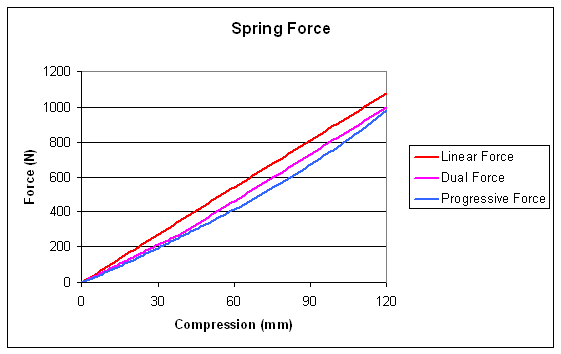
The graph above shows how much force is required to
compress each of three different types of spring a
certain amount. You just look up the amount of
compression along the bottom edge, move vertically
up until you hit the appropriate colour line (as per
the list at the right), then move horizontally
across to read off the force.
The feature that is immediately obvious is that the graphs all go up as they go right: more compression means more force. Makes sense, right?
The three spring types are linear (ordinary); dual rate (often called
"progressive") and progressive (really!). The ordinary one has a rate of
9N/mm, so to get compressed 120mm it needs 120 x 9N of force, or 1080N. Note
that the graph is a straight line, which is why itís called linear.
Dual rate springs are made by putting a short spring with closely wound
coils on top of a longer spring. Initially, when you apply a force it acts
on both springs and they both compress. So the total compression is more,
for the same force, than either spring alone. That means it has a softer
rate. If you don't like formulae, just ignore the next sentence. If you
don't mind, the combined rate is K=K1 * K2 / (K1 + K2), where K1 and K2 are
the rates of the individual springs.
However, after some compression, the closely wound spring jams solid as all
the coils come together (it "coil binds"). So now you only have a single
spring, which weíve already said is stiffer than the combined springs. In
the example above, the combined springs have a rate of 7N/mm, while the
second spring has a rate of 9N/mm. The first spring coil binds at 40mm: you
can see a kink in the graph at that point. Note that the two springs can be
made from the same piece of wire: all that matters is that their coils have
different spacing. By the way, the above numbers mean that the initial part
of the spring must have a rate of 31.5N/mm: itís wrong to suppose that the
first part is a soft spring!
While many people call dual rate springs progressive, true progressive
springs have gradually increasing coil spacing, so that the coils bind up
one by one. So if you look at the plot for the progressive spring above
there is no sudden change in slope, it just gradually curves upward.
Graphing the rate
So how do I read spring rate from the graph?
Remember that rate is
the amount of additional force to compress the spring an extra 1mm.
Or in other words, how far the graph moves up for 1mm to the rightÖ or its
slope. The linear spring has the same slope all the way, the dual rate
changes slope after 40mm, while the slope of the progressive spring
increases gradually all the way.
We could just graph the slopes directly, which makes things clearer:
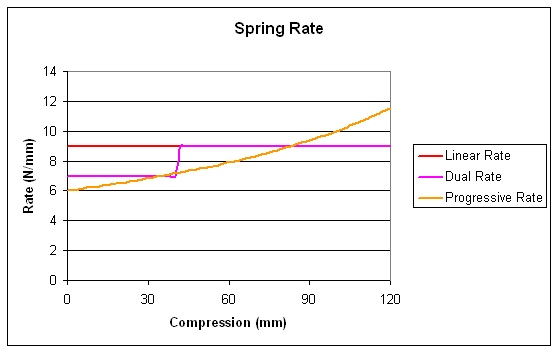
The only danger of looking at this is that the
sudden step at 40mm looks a bit scary, which it
actually isn't.
Would you like preload with that?
So what happens if we add preload? All that means is
we have already compressed the spring a bit before
we start measuring. On the force graph it looks like
weíve moved things up, but in fact weíve moved them
to the left. Check the position of the kink in the
dual rate spring to see this. The graphs below have
15mm preload
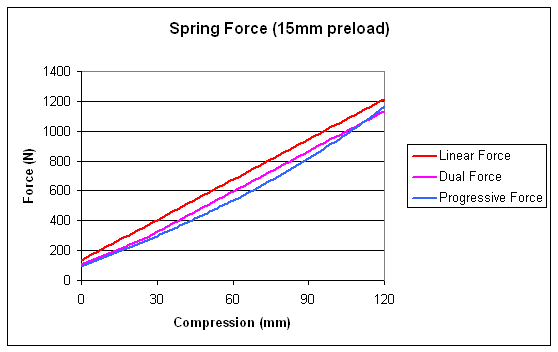
It's a little clearer on the rate graph: the linear
spring rate doesnít change at all, while the others
just shuffle across to the left a little.
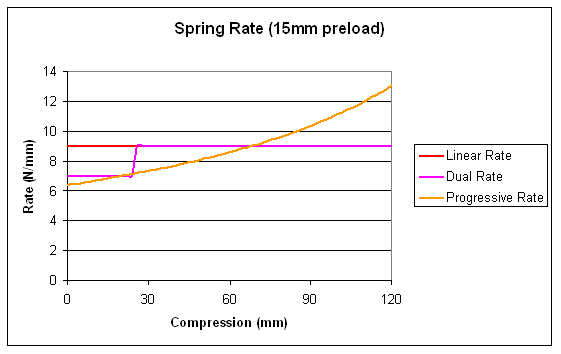
Digression
No, I'm not going off on a tangent. Springs that get
softer as they go down are called digressive. I
guess it sounds better than regressive and the
political metaphor doesnít work: all springs are
technically conservative, which means they store
energy and return the full amount.
We actually discussed digressive springs back in
part 2 (Sag and Preload), where I called them top-out
springs. We arrange one spring pushing up and one
pushing down, opposing each other. That means their
rates add, K=K1 + K2. Now if you press down far
enough, the upper spring will reach its free length
and just stop doing anything. At that stage you only
have K2, but this time itís smaller than the
combined rate. What Iíll show below are the force
and rate graphs for a 9N/mm main spring, with a
4N/mm top-out spring which extends 35mm before
giving up.
Notice that initially less force is required,
although the slope is steeper.
One perverse question you might have at this stage: what
if I combine a dual-rate main spring with a top-out spring? The rate would
either go down then up again, or up then down, depending on the relative
lengths of the various spring components.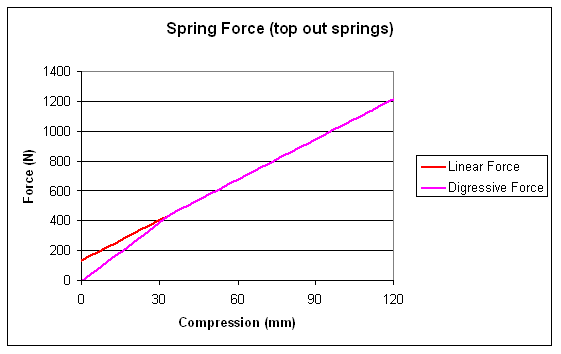
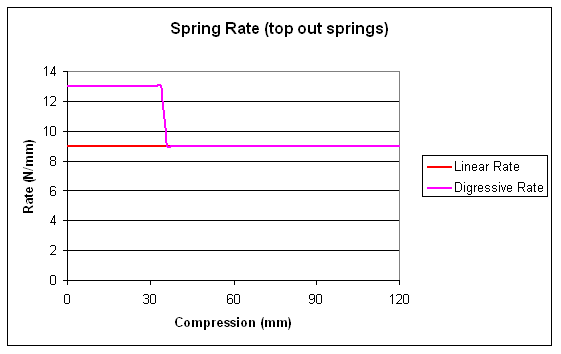
Honda actually used this set-up on their CBR600RR!
Is it a good idea then?
Iíve already explained why top-out springs make sense, although now I can
just point to the force graph above: less force is required to move the
suspension when it is lightly weighted, such as when accelerating out of a
corner.
Progressive springing is much less popular for road-racing, with linear main
springs used almost universally. There is a good reason for this: going
around corners compresses your suspension, by quite a lot with modern race
tyres. With progressive or dual rate springs, that means the suspension is
going to be stiffer than when upright. However mid corner is also where you
most need good grip and would really prefer your tyres not to be bouncing
off the ground.
This has led to a more extreme form of digressive suspension, where the rate
changes below the rider-sag point. In principle this can compensate for high
lean angle and provide better mid-turn grip. Typically itís achieved via a
linkage system at the rear: the 2004/5 ZX10R has a weakly digressive rear
suspension. Also, Honda introduced a significantly digressive rear
suspension on their 2001 RS250 race bike, replacing the strongly progressive
system on the 2000 and earlier models. Both suffer from problems driving out
of corners. After-market race-kit manufacturer quickly provided alternative
linkages for the RS250, while the ZX10R can be made linear with some longer
dog-bones and a spacer under the top shock mount. Thereíll be more about
linkages in a later article.
Dual or progressive rate springs are really a compromise that allows
low-speed comfort without excess bottoming, which is why Honda fit them to
road bikes. Racing is not about compromise, so they donít get used for that.
Dirt bikes may be another matter, since they need to cope with jumps and
big, big bumps. However there is still a problem: it's desirable that your
suspension is configured with damping to match your spring rates. Rebound
damping in particular needs to be stronger to prevent a stronger spring from
recoiling. However if the spring rate changes, it's tricky to make the
damping change to suit. KTM have some tricks for doing it on their PDS dirt
bikes, with limited success.
There are other ways of achieving variable rate rear suspension, via linkage
systems as mentioned above. I'll discuss them in a future article, along
with the role of air and oil height in forks.
Summary
- If we graph force versus position we can see the effect of different spring types. The slope of the graph is the spring rate.
- We can arrange springs so that the spring rate increases (progressive), decreases (digressive) or remains constant (linear) through the suspension stroke.
- Progressive or dual-rate suspension is a compromise for comfort, it's not ideal for race-track use.
Springs Advanced
© Graham Byrnes
